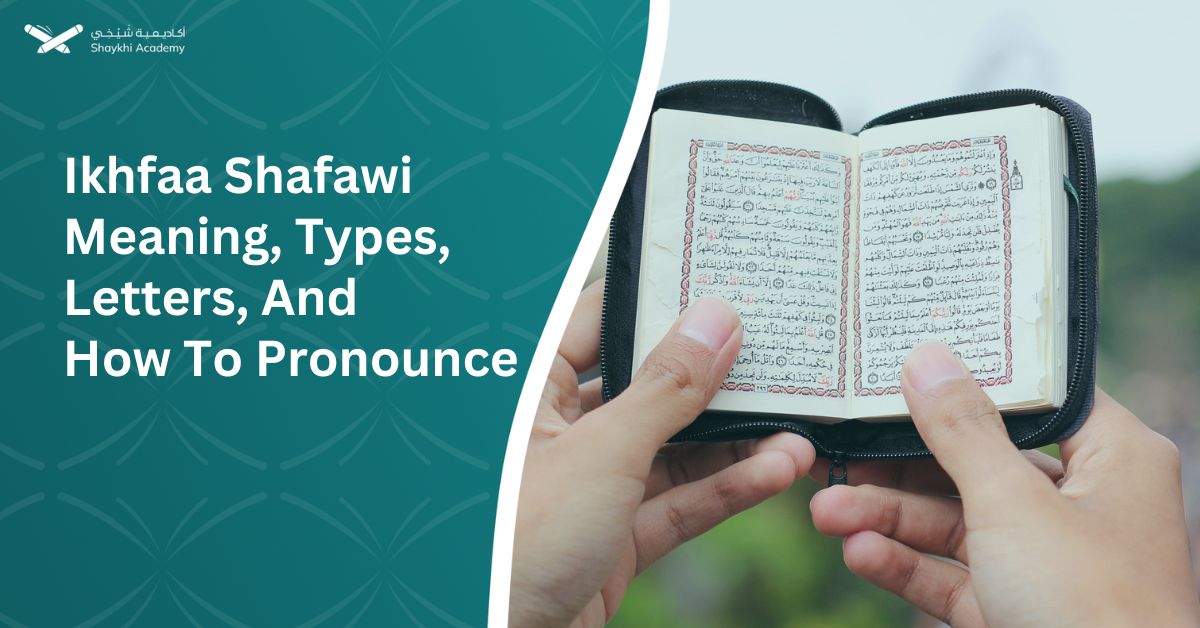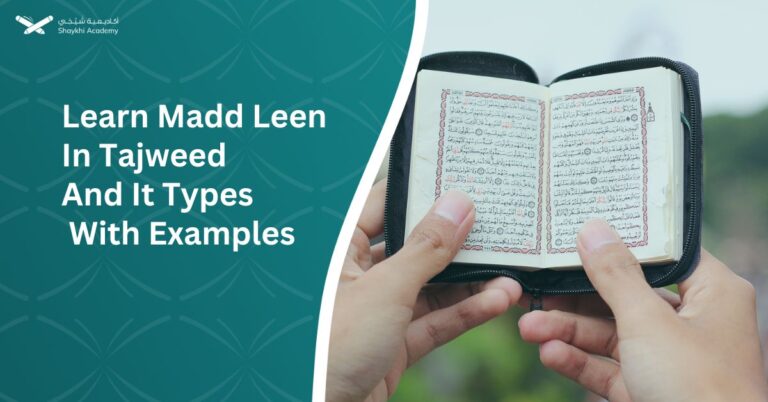Ikhfaa Shafawi, a rule in Tajweed, involves concealing the pronunciation of the silent letter “Meem” when it appears at the end of a word followed by the letter “Baa” (ب) at the beginning of the next word.
This concealment occurs in an intermediate state between clear pronunciation (Izhar) and assimilation (Idgham), accompanied by a ghunna.
It is indicated in the Mushaf by the absence of a sukun on the Meem. Understanding Ikhfaa Shafawi is crucial for accurate Quranic recitation.
Tajweed includes a number of rules that help us read the Holy Quran correctly. Among these rules is the rule of concealment (Ikhfaa), which is divided into real concealment (Ikhfaa Haqiqi) and oral concealment (Ikhfaa Shafawi). In this article, we will discuss oral concealment in detail…
What is Ikhfaa Shafawi?
It is one of the Sakinah Meem rules, which is that the sakinah Meem comes at the end of the first word and is followed by the letter baa “”ب at the beginning of the second word, and then the sakinah Meem is pronounced in an intermediate state between apparent (Izhar) and assimilated (Idgham) without stress, with the ghunna remaining for two vowels.
Ikhfaa Shafawi only occurs in two words. And its sign in the Mushaf is the deletion of the sukun from the Meem, and not stressing what comes after it.
In short, we can say that Ikhfaa Shafawi is to hide the silent Meem if it comes at the end of a word and is followed by a “baa” and this is accompanied by a ghunna.
What are Ikhfaa Shafawi examples in Quran?
There are a large number of verses in Quran that contain Ikhfaa Shafawi, for Example …
In Surah Al-Baqarah, God Almighty says:
(Tell them their names) (أَنبِئْهُم بِأَسْمَائِهِمْ)
(When he told them their names) (فلمّا أَنبَأَهُم بِأَسْمَائِهِمْ)
(And in that is a trial) (وَفِي ذَلِكُم بَلَاءٌ)
(Hold fast that which we have given you) (خذوا ما آتَيْنَاكُم بِقُوَّةٍ)
Other examples of Ikhfaa Shafawi from the Holy Quran:
(The day you see the believing men and believing women, their light running before them and through their oaths, good news for you today of Gardens with rivers flowing beneath them, wherein they will abide) (يَوْمَ تَرَى الْمُؤْمِنِينَ وَالْمُؤْمِنَاتِ يَسْعَىٰ نُورُهُم بَيْنَ أَيْدِيهِمْ وَبِأَيْمَانِهِم بُشْرَاكُمُ الْيَوْمَ جَنَّاتٌ تَجْرِي مِن تَحْتِهَا الْأَنْهَارُ خَالِدِينَ فِيهَا).
(Those who perform prayer and pay zakat and are certain of the Hereafter) (الَّذِينَ يُقِيمُونَ الصَّلَاةَ وَيُؤْتُونَ الزَّكَاةَ وَهُم بِالْآخِرَةِ هُمْ يُوقِنُونَ).
(And your companion is not crazy) (وَمَا صَاحِبُكُم بِمَجْنُونٍ).
(And they have no knowledge of it) (وَمَا لَهُم بِهِ مِنْ عِلْمٍ).
(She throws stones made of clay at them) (تَرْمِيهِم بِحِجَارَةٍ مِّن سِجِّيلٍ).
Why was Al-Ikhfaa Ash Shafawi Named with That Name?
Ikhfaa Shafawi was named (Shafawi) Because the Meem and baa emerge from the lips, due to the union of the letters Meem م and baa ب in the exit and their closeness in the attributes.
What is The Difference Between Ikhfaa Shafawi and Ikhfaa Haqiqi?
As we mentioned above, Ikhfaa is one of the important rules in Tajweed and is divided into Ikhfaa haqiqi and Ikhfaa Shafawi.
Ikhfaa Haqiqi
As for Ikhfaa Haqiqi, it is one of the rulings on the Noon Sakinah and Tanween, and the Noon Sakinah or Tanween is pronounced in a state between Izhar and Idgham, without stress, with the presence of an accent of two vowels, and this occurs when there are fifteen letters, which are (ص، ذ، ث، ج، ش، ق، س، د، ط، ز، ف، ت، ض، ظ).
Ikhfaa Shafawi
As for Ikhfaa Shafawi, it is one of the rulings on the silent Meem when the letter baa ب occurs after the silent Meem letter, and an example of this is almighty saying:
(وَأَيَّدَكُم بِنَصرِهِ)، الأنفال: آية 26
(And He supported you with His victory), “Al-Anfal: Verse 26”
This is done by reducing reliance on the source of the meem, which is the lips, by closing them with the ghunnah by two movements.
What are Ikhfaa Shafawi letters?
Ikhfaa Shafawi has only one letter, which is the letter “baa” “ب” .
What is Ghunnah in Ikhfaa Shafawi?
Ghunnah is a light sound that comes out of the nostrils and does not involve the tongue. Its range or time is determined by the movement, which is the same as a person clenching or extending his finger, without haste or delay.
The Ghunnah in Ikhfaa Shafawi, as we mentioned, results from concealing the silent Meem (م) when it meets the letter baa (ب), whether it is in one word or in two words, such as the Almighty’s saying: (He holds fast to God) (يعتصم بالله) for example.
The Ghunnah is extended in Ikhfaa Shafawi by two movements.
What makes the Ikhfaa Shafawi?
The reason for hiding the sakinah Meem is due to the presence of homogeneity in the adjective and articulation of these two letters, which are the Baa and the Meem, as both letters emerge from the articulation of the lips, and according to this, showing them together is difficult to pronounce when they meet, so the process of hiding the weaker letter, which is considered here as the sakinah Meem, should be completed.
How to pronounce Ikhfaa Shafawi?
As for the pronunciation of Ikhfaa Shafawi, it is by reducing reliance on the exit of the Meem (the lips), while introducing the ghunna by two vowels.
What is The Difference Between Al Ikhfaa Ash Shafawi and Al-Idgham Ash Shafawi?
Al-Idgham Ash Shafawi occurs by assimilation of the consonant Meem only in its counterpart, which means in the letter Meem, so they became (the assimilated Meem and the assimilated Meem in it) become one Meem stressed with a ghunna.
This assimilation is incomplete, as the ghunna remains an attribute of the assimilated letter. It contains one letter, which is Meem م
like:
﴿الَّذِي أَطْعَمَهُم مِّن جُوعٍ وَآمَنَهُم مِّنْ خَوْفٍ﴾
“Who fed them against hunger and secured them from fear”
As for Ikhfaa Shafawi, it is that the silent Meem disappears when it meets the baa with a ghunna, so it is regardless of whether the Meem is an original one, such as:
﴿ وَهُمْ بِالآخِرَةِ ﴾
“And they are in the Hereafter”
Or an inverted Meem from a tanween or a noon sakinah, such as:
﴿مِنْ بَعْدُ﴾
“From after”.
Unlock the Path to Quranic Mastery with Shaykhi Academy!
Are you seeking the finest Quranic education right from the comfort of your home? Look no further! Shaykhi Academy stands out as a premier online Quran learning platform, dedicated to providing exemplary education to both children and adults.
Why Choose Shaykhi Academy?
- Connect with highly qualified native tutors.
- Flexible scheduling to suit your busy lifestyle.
- Affordable classes tailored for all levels.
- Accessible from anywhere around the globe.
Discover Our Range of Courses:
- Arabic Noorani Qaida: Lay a solid foundation for Quranic studies.
- Online Quran Classes for Kids: Engaging lessons for lifelong learning.
- Tajweed Rules for Kids: Learn to recite with confidence.
- Quran Hifz for Kids: Step-by-step guidance to memorize the Quran.
- Quran for Adults: Introduce yourself to Quran reading and Tajweed rules.
- Online Arabic Courses: Master the language of the Quran.
- Islamic Studies: A wide range of topics related to Islam, including theology, law, Quranic studies, Hadith.
Don’t Miss Out on Your Chance to Excel!
Whether you’re a beginner or seeking advanced knowledge, Shaykhi Academy can guide you! Book your free trial now and make Ramadan 2024 your Quranic turning point!
Concluding Statement:
Mastering the rule of Ikhfaa Shafawi in Tajweed is essential for precise Quranic recitation. By recognizing its application, understanding its examples, and practicing pronunciation with proper ghunna, learners can enhance their recitation skills and deepen their connection with the Holy Quran, ensuring reverence and accuracy in their reading.




















